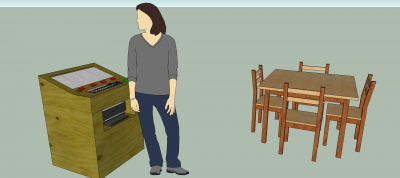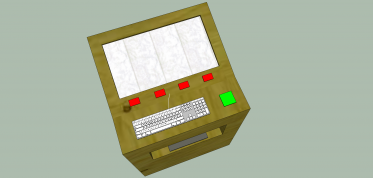User:Mirjam Dissel/Mirjam Dissel, In My Mind's Eye, 2012: Difference between revisions
(→Media) |
|||
| Line 12: | Line 12: | ||
== Description == | == Description == | ||
''In My Mind's Eye'' is a machine that allows the user to make associations that lie deep within them; these are personal for each user. The machine takes its mechanism from that of a slot machine, where the images are replaced with scraped data; a script uses a simple English dictionary to scrape images from different sources, to ensure a spectrum as broad and random as possible to ensure free association. After a set is created the user names the set and prints out the cards, they now become part of a personalized game of quartet. | ''In My Mind's Eye'' is a machine that allows the user to make associations that lie deep within them; these are personal for each user. The machine takes its mechanism from that of a slot machine, where the images are replaced with scraped data; a script uses a simple English dictionary to scrape images from different sources, to ensure a spectrum as broad and random as possible to ensure free association. After a set is created the user names the set and prints out the cards, they now become part of a personalized game of quartet. | ||
Revision as of 02:13, 10 May 2012
Name, Trimester (1, 2 or 3), Year. OR Name, Graduation Project, Trimester (4, 5 or 6), Year.
NOTE: All documentation material, PDF, photos, videos, etc, must be uploaded to the wiki. No embedding or third party hosts allowed, for obvious archiving issues ;)
NOTE: Please use "your name, the title of your project, the year" as page name.
In My Mind's Eye
UNDER CONSTRUCTION STILL
Description
In My Mind's Eye is a machine that allows the user to make associations that lie deep within them; these are personal for each user. The machine takes its mechanism from that of a slot machine, where the images are replaced with scraped data; a script uses a simple English dictionary to scrape images from different sources, to ensure a spectrum as broad and random as possible to ensure free association. After a set is created the user names the set and prints out the cards, they now become part of a personalized game of quartet.
By giving the subject boundaries I force them to make associations. They can change the images in the set by spinning the wheels. Similarly to Freud's theory of free association, when the wheels are spinning, images pass and accumulate in the user's mind and get assessed in a second moment. Like a collage, a set is collected that is meaningful to the user. For the same reason as above I use the framework of the quartet game; it sets boundaries for the user in order to force free association. Both mechanisms have exactly what is needed to force association: they have a strict taxonomy and allow people to create a narrative with images. By putting new images into this format, automatically you see them in a taxonomy, on the same level, and you start to look for links between them. There is no need to force yourself to see a link, the game structure helps you do this automatically. It opens up the creative unconscious and allowing a more free and much more personal association. The result gives us a peek into their inner self, into their mind and brain.
After printing (multiple) sets of images, on a table next to the machine, visitors can communicate these generated associations by playing the quartet (/go fish) game they've just printed out, and possibly mix their decks and interpret each other's sets. I'm still considering the possibilities and the ways in which these moments can be recorded and what the possible uses are of that information.
I will then reorganize the data in the collection gathered and give it meaning. I've taken inspiration from my previous graduation project and The World Explained by Erick Beltràn. The topic people have chosen for their quartet set will become the title of an encyclopaedia page. The images will be superimposed, and will then become a page in the encyclopaedia, in which each page reflects a personal association. The role of the encyclopaedia and how it will it be collated, displayed and distributed, is still in a conceptual phase. I'm thinking of an encyclopaedia that will be printed at the end of every day, where each section represent a day's worth of data collected. But it might as well turn out to be an interactive database that functions as a visual dictionary where one can look up the different meanings given to the picture of a car.
My aim for this project therefore is collecting different types of results, whether it will be personal results based on experiences from people, or something they associate through popular culture, current events, etc.
Media
Photos
Example of previous work where I superimposed multiple scans of a collective of people's work.
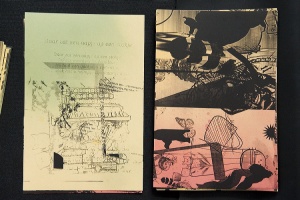
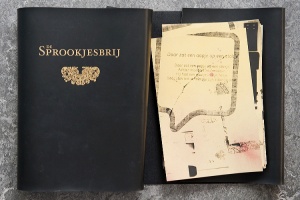
"The World Explained". Example of an encyclopedia seen from a microhistoric perspective. With personal theories on distant subjects.
By Erick Beltràn, Tropenmuseum 2012
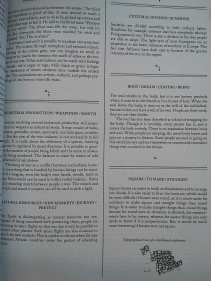
- card sets outcome
Video
Snapshot of how the machine's current state
Essay
Abstract and bibs/ref + link to PDF (PDF must be uploaded to wiki).
Use Steve's recommendations for abstract length and bibliographic style.
Additional Information
non optional
- One page itemised budget estimate
optional
- Project URL (if lives on an external site)
- extra wiki links (in case you have relevant notes/journals/documentation in your User: page, this is useful particularly if you have been asked to articulate further or refine your project during your assessment)
- Animated GIFs

